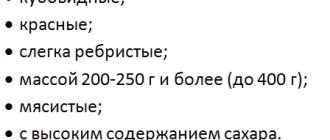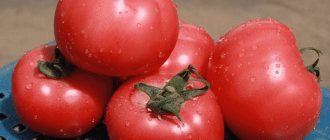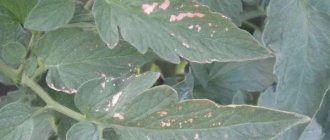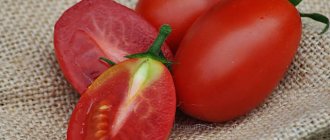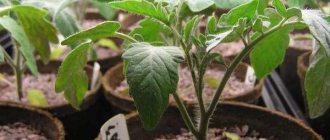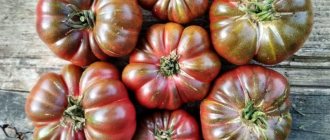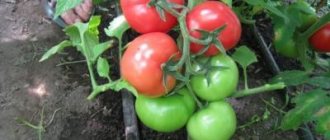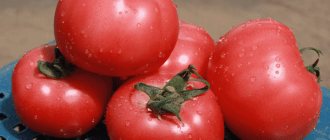Every gardening season, farmers strive to plant something new. American breeders presented an interesting new product - the Heinz 3402 F1 tomato, which is easy to care for and produces abundant harvests.
| Height | Landing location | Ripening time | Fruit color | Fruit size | Origin | Fruit shape |
| Medium height | Greenhouse, Open ground | Early ripening | Reds | Average | Hybrid | Plum-shaped or oval |
Ultra early hybrid from Heinz seed
Among the Heinz tomato seeds, 2206 F1 is distinguished, which bears fruit 85 days after the appearance of the first shoots. Already in June you can enjoy the first tomatoes, which are located on powerful bushes.
The variety is distinguished by:
- high productivity;
- excellent taste of medium-sized red fruits;
- resistance to diseases such as fusarium and verticillium;
- plant adaptation to temperature changes, drought;
- versatility in using tomatoes.
Determinate tomatoes are suitable for growing both in open and closed ground.
Preparing and sowing seeds for seedlings
Seed preparation begins at the end of winter:
- sort and sort the seed material, selecting large specimens of the correct shape
- selected seeds are placed in a gauze or fabric bag and kept in a strong manganese solution for about 30 minutes
- disinfected seeds are washed under running water for 20 minutes without removing them from the bag
- washed seeds are placed on a wet cloth fertilized with microfertilizers for home flowers and a growth stimulator
- The seed material is covered with polyethylene on top, preventing it from coming into contact with the seeds, and placed in a warm place
- after a day, the seeds are placed in the lower compartment of the refrigerator for 3-4 hours, and then again in a warm place for a day. The alternation is repeated three times and left warm for germination.
The roots should appear in three to five days, after which you can start sowing. The time for sowing tomatoes differs in different climatic zones. Planting is carried out when the threat of spring frosts has passed. If conditions are favorable, the seedlings will be ready for transplanting into the ground in two months. If you plan to grow tomatoes in a greenhouse, then sow the seeds for seedlings three weeks earlier.
The crops are watered, covered with polyethylene and placed in a warm place. Within a week, the seeds will sprout. With the emergence of seedlings, the polyethylene is removed, the soil is moistened and the seedlings are placed in a well-lit place.
If the seedlings are grown in a common box, then when two pairs of leaves appear, they need to be planted in separate containers. This is done so that the seedlings do not stretch out and their root system becomes stronger. After picking, the seedlings need to be regularly watered and fed with complex mineral fertilizers. And two weeks before transplanting into the ground, the grown seedlings should be hardened off. At this time, watering is limited and the seedlings are gradually accustomed to sunlight.
Features of mid-early tomatoes
Heinz 3402 tomatoes are very popular among vegetable growers, their popularity throughout the world is growing year by year. During mass production of vegetables, up to 120 tons are harvested per hectare. The ripening period of a tomato reaches 110 days after germination. The description of the tomato indicates the high quality of the fruit.
They are shaped like a plum and, when fully ripe, have a deep red color without any green spots. Juicy tomatoes weigh about ninety grams. They are used to prepare tomato pastes, ketchups, sauces, and juices. The advantages of the vegetable product include:
- high quality fruits;
- the highest level of tomato color and structure;
- resistance to adverse environmental conditions;
- ease of care;
- excellent keeping quality, transportability;
- Excellent fruit set even at high temperatures.
Heinz 3402 F1 is considered the number 1 hybrid in the world.
See also
Characteristics and description of the tomato variety Bullfinch, its yieldRead
Description of the ultra-early hybrid tomato Ksenia and growing tips
Tomato Ksenia F1 is an ultra-early hybrid. The first tomatoes are harvested 3 months after planting the seeds. The variety was bred by domestic breeders specifically for the characteristics of our climate. Despite the fact that it is a hybrid, it does not have the artificial taste inherent in its imported counterparts.
What is a Ksenia tomato?
Characteristics and description of the variety:
- Tomato Ksenia is a determinate plant, reaches a height of 90 cm.
- The bushes are medium-leaved, however, the plant requires garter.
- The fruits are round, red, with thick skin.
- Per 1 m² (in 2 harvests) up to 8-9 kg of harvest ripens. Tomatoes can be planted both in open ground and under film cover.
How to grow tomatoes?
Planting of seeds begins 2 months before planting the seedlings in a permanent place. The optimal time to start germinating seeds is early April.
To obtain rapid germination, seeds can be treated with a solution of a special growth stimulator. It is better to spread the seeds on a soft cloth moistened with water. To avoid drying out, they are placed in a plastic bag.
When the grains hatch, they need to be planted in the soil to a depth of no more than 2 cm. Sprinkle with a thin layer of soil and spray with water. Having created greenhouse conditions (film covering and temperature +25 ºС), you need to wait for shoots.
The next step is picking the plants. As soon as the first leaves appear, the seedlings are transplanted into separate pots and placed on a windowsill or a bright balcony. Seedlings need a lot of light to grow properly. Watering is done as the soil dries out. Tomatoes really like nettle, so to feed the root system, you can water it once a week with a 3-day decoction from this plant.
10-14 days before the intended planting in the ground, seedlings must be hardened off. For this purpose, in the first 2 days, the room in which the pots with plants are located is intensively ventilated. Then they are taken outside for 10-15 minutes. Every day the time interval is increased, and on the last day they are left outside overnight.
2 bushes are planted per 1 m². They must be tied to a support to help the brushes withstand the weight of the tomatoes. They are usually formed into 2 stems and planted. Before planting, the soil is loosened and fertilized with mineral fertilizer. The same procedure is repeated after 2 weeks. Tomatoes need to be watered sparingly, as frequent watering causes the root system to rot.
An important procedure is weeding and loosening the soil in the root system. This is done to maintain soil moisture
It is necessary to remove weeds, as they feed on fertilizers from the soil, leaving no nutrients for the tomatoes.
The best time for planting in the ground is early June. At this time, the air atmosphere and soil warm up sufficiently, which creates additional comfortable conditions for the growth of tomatoes. The Ksyusha hybrid is often grown for commercial purposes, as the tomatoes ripen quickly, have good taste, are stored for a long time and can withstand long transportation.
Reviews from gardeners about this variety of tomatoes are positive. Vegetable growers note the high yield and excellent taste of tomatoes, as well as resistance to diseases. When planting tomatoes, conditions, soil quality, type of fertilizing and plant care are of great importance. That is why the same variety gives different results from different vegetable growers. If you are a beginner gardener, then before growing, carefully study the characteristics of this crop and listen to the advice of experienced agronomists. This way you can avoid some mistakes when landing.
moefermerstvo.ru
Rules for preparing tomato paste
You can prepare delicious natural tomato paste at home. It will have a pleasant taste, you can add herbs to it as you wish. Prepare the pasta by simmering the tomatoes over low heat for some time. After cooling, the mass is rubbed through a sieve.
After the procedure, place a saucepan with tomato puree on low heat, boiling until the mass thickens. Then add salt and sugar to taste. Jars of tomato paste must be pasteurized and sealed.
Growing tomato Nina: from seedlings to planting in open ground and greenhouse
To obtain high yields from this variety, it is necessary to provide it with special care, as well as to properly grow the seedlings.
It is optimal to plant Nina tomato seed material in the second ten days of March. Moreover, you can plant pre-soaked seeds, but you can also sow them dry - they still germinate at about the same time.
Photo of tomato seedlings Nina
But for better plant growth in the future, it is recommended to keep the seed material in a solution of special nutritional preparations before planting. You can also use ash solution for this - 4 tbsp. l. wood ash is diluted in 2 liters of hot water. This solution should be infused for a couple of days.
It is better to immediately plant the seed material in separate containers, so as not to further injure the plants during the diving procedure. Soil for planting can be purchased at gardening stores or prepared at home. To do this, river sand is mixed with humus, and there should be more sand. To make the soil looser, you can add chopped sphangnum moss to it.
Growing beef tomatoes in a greenhouse - video
After planting, the containers are covered with polyethylene and placed in a warm place for germination. Usually the first shoots appear after 6-8 days.
After this, the polyethylene is removed, and the containers with Nina tomato seedlings are placed in a well-lit place. In the first days, the temperature in the room must be lowered so that the seedlings harden. Then the containers are transferred to a warmer place with a temperature of at least 21-22 degrees Celsius.
THE BEST VARIETIES OF TOMATOES! Tomato Pride of Siberia Tomato Argonaut Tomato King of the Giants
If the seedlings have sprouted too thickly, they should definitely be pruned. Water the plants first. Each plant is carefully removed from the soil, trying not to damage the roots. The central root is pinched to stimulate the growth of lateral roots. Then the plants are transplanted into another container, deepening them to the first leaves. The soil is compacted and the containers are moved to a shaded place.
Watering of pruned seedlings is carried out 2-3 times a week.
10-12 days before transplanting tomatoes to a permanent place, they begin to harden them, taking them out into the air for a short time. But gradually the period of stay of plants outside is increased.
Photo of transplanting tomato seedlings
Nina tomato seedlings are transplanted into open ground garden beds in mid-May.
Seedlings can be planted in the greenhouse earlier - in the last days of April.
The distance between neighboring tomatoes in rows is 0.5 m, and the row spacing is 0.4 m. 3-4 plants should be planted on each square of area.
What aspects should you focus on to get a good harvest?
The Heinz variety has no) (including hybrids, all varieties ripen together, which is especially convenient for gardeners. To get a good harvest, experts recommend adhering to the following recommendations:
- If you plan to plant plants in open ground, you need to immediately select the most illuminated place.
- Calculate in advance how many seedlings will be needed, since forcing is carried out at different times.
- The containers where planting will be carried out must be disinfected (potassium permanganate or vodka is used for this).
- The soil needs to be forward. Ant. then prepare it (sold ready-made in specialty stores, or make it yourself: caustobiolite + compost + turf soil).
- Before preparing the soil mixture, all ingredients must be kept frozen for about one week.
- Seeds definitely need to be prepared: evaluate germination, place in potassium permanganate for disinfection, and keep in a stimulator for 30 minutes.
- For the best germination time, it is important that it be warm - at least 25 ⁰C.
- Make sure there is gas exchange.
- When the first loops appear, the temperature needs to be reduced to +18 ⁰C.
The variety is popular among gardeners due to the fact that it tolerates unfavorable weather conditions well: sudden temperature changes, lack of taste of sufficient moisture, etc. Plants tolerate both heat and cold and continue to bear fruit.
By growing region
Every year, breeders create new species with high quality indicators. In stores you can buy specialized varieties of tomatoes designed for growing in certain climatic conditions. Classification by regions of Russia:
- for the Moscow region: Champion, Sweet Bunch, Honey, Pink Elephant, Fireworks, Bull's forehead;
- for the southern regions: Torch, Novice, Titan, Winner, Bison, Ermak, Gift, Mikado;
- for the middle zone: Bull's Heart, Black Prince, Uzbek (Yusupov), Moskvichka, Snowdrop, Big Brother, Spasskaya Tower;
- for Siberia: Siberian heavyweight, Ultra early ripening, Sanka, Abakan pink;
- for the Urals: Coin, Bull's Heart, Button, Countryman, Yellow Buyan, Bullfinch, Demidov;
- for the far north: Snowy Tale, Ballerina, Ladyfingers, Berdsky Large, Countryman, Oak, Gina.
An unpredictable, cold or, conversely, excessively warm climate is not a reason to refuse to grow tomatoes in open ground. Thanks to selection, varieties have been developed that grow and develop well in any terrain.
Agricultural technology
From this it is clear, now let’s look at what steps need to be followed in order to grow good, strong plants and get an excellent harvest.
- How to plant.
Soak the seeds and place them 1 cm deep in pre-developed soil. Afterwards, they need to be covered with film. Just as leaves (at least 2) begin to form, the sprouts are transplanted into separate containers. It is of fundamental importance that the seedlings receive a sufficient amount of light, and the plants also need to be fertilized occasionally in order to get a good harvest in the future. After about 2 months, the seedlings will become stronger and can be moved into open ground. - How to educate.
The bushes should be placed at a distance of 30 cm from each other. It is not necessary to remove the lower shoots, but a garter is needed. Don’t forget to take care of the attachments: water regularly, loosen the soil, introduce fertility granules. - Harvesting.
You can start collecting at the end of July. Due to the fact that the fruits ripen in waves, they need to be collected in accordance with how they ripen. Tomatoes have an excellent sweetness - they can be used fresh, heat-treated, or canned.
As you can see, this variety really has excellent characteristics. Sympathy is widespread both among consumers and among farmers due to the fact that the plants are easy to care for, they are not susceptible to diseases, they give a good harvest and at the same time have wonderful taste.
